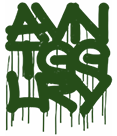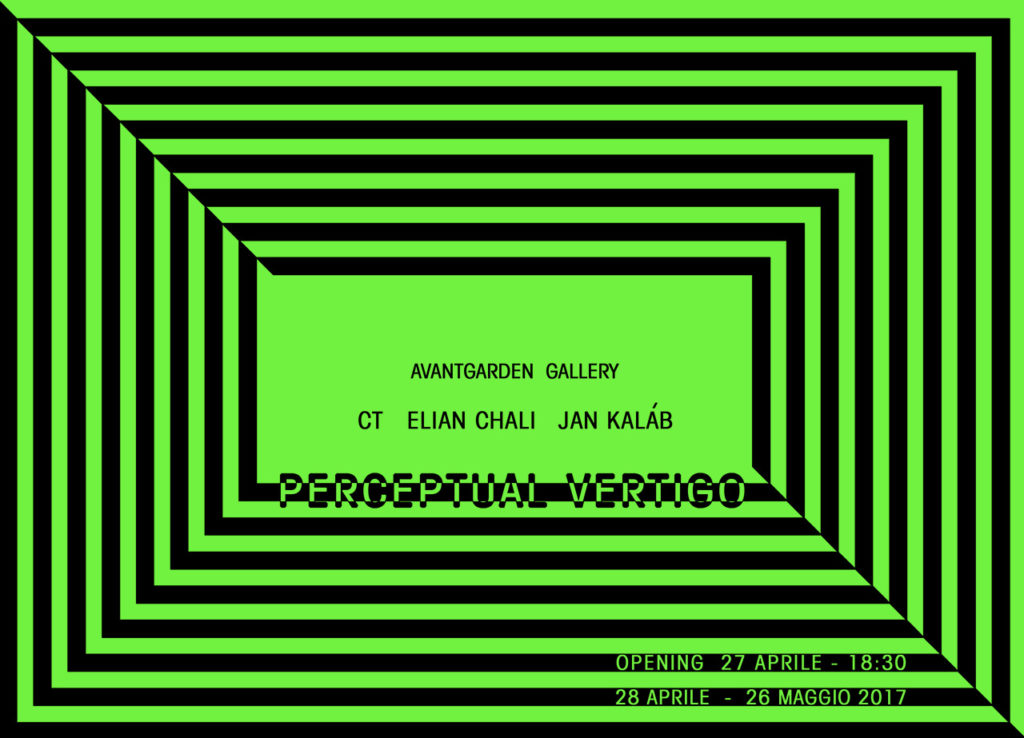Vernissage 27 Aprile 2017 – h.18:30
28 Aprile – 26 Maggio 2017
A cura di Manfredi Brunelli Bonetti
Testo critico di Francesca Holsenn
Avantgarden Gallery compie 10 anni di attività.
La galleria, rinomata nel promuovere una cultura d’avanguardia che sta trovando sempre più spazio anche in Italia, presenta PERCEPTUAL VERTIGO, mostra collettiva di un trio internazionale d’eccellenza: CT, ELIAN CHALI e JAN KALAB.
I tre artisti sono attivi in tutto il mondo e il loro lavoro, maturato negli anni, ha conquistato estrema popolarità, assegnando alle tre individualità un ruolo fondamentale nello sviluppo e nel riconoscimento della street art globale e non solo.
CT, ELIAN CHALI e JAN KALAB provengono dal graffiti writing ma hanno intrapreso un percorso artistico che li ha portati lontano, verso una sintesi grafica e cromatica del segno, che è allo stesso tempo asciutta e prepotentemente profonda e seduttiva. Allontanandosi da quella che poteva essere definita “leggibilità” della lettera, attraverso lo studio e dunque la proposta della pura forma astratta, il lavoro dei tre artisti mantiene la forza espressiva di un’arte che nasce storicamente e trae ispirazione dalla strada e dalle visioni che solo un paesaggio (in)contaminato può instillare in chi lo vive o lo ha vissuto, creando allo stesso tempo dispositivi artistici e intellettuali capaci di andare oltre alla questione writing/streetart vs contemporaryart.
Avantgarden Gallery, riconoscendo nei tre le radici del puro segno ognuno caratterizzato da sintassi e grammatiche proprie, propone ai tre artisti un’indagine dall’inclinazione metafisica che ci riporta alla natura fondamentale della forma, alla sua tensione interna, ponendoci in “ascolto” del suo sottofondo invisibile.
CT, ELIAN CHALI e JAN KALAB propongono, negli spazi della galleria, interventi site-specific che, come afferma il gallerista Manfredi Brunelli Bonetti, “sono d’ispirazione a un Kandinsky contemporaneo, in cui vengono enfatizzati punto, linea e superficie”. Con Punto Linea Superficie, Wassili Kandinsky propose, nel 1926, la costruzione delle basi di una nuova scienza dell’arte. Nel libro, attraverso un approccio che si avvicina a quello scientifico e matematico, l’atto creativo irrazionale viene affiancato da un’ordine di tipo estetico che si ritrova anche nell’architettura e nel design, nonché nella musica sinestetica di Aleksandr Skrijabin, ordine che ritroviamo nell’espressione artistica dei tre protagonisti di PERCEPTUAL VERTIGO.
Non solo. Nel lavoro dei tre artisti sembra strisciante e presente tutta la storia dell’astrattismo, dall’enfasi di Kandinsky nelle cui forme è facile riconoscere indizi nel lavoro di tutti e tre gli artisti, passando per il neoplasticismo riconoscibile nell’approccio di CT, per lo spazialismo individuabile soprattutto nei lavori di JAN KALAB, ma anche per l’arte cinetica visibile nello studio delle illusioni prospettiche utilizzate da ELIAN CHALI nei suoi lavori site-specific. Si tratta di artisti ormai divenuti radicali nei loro interventi site-specific, che trasformano lo spazio, domandolo e mai dominandolo. Il segno diventa ipnotico, grazie anche alla dimestichezza che i tre hanno con la terza dimensione, alla stregua di un’illusione ottica che invita a un inedito e programmato viaggio percettivo.
PERCEPTUAL VERTIGO è quindi una vertigine percettiva, guidata da un mantra cromatico, una vertigine “controllata” dalla capacità dei tre artisti di “aprire” lo spazio fisico anche all’illusione e alla virtualità. Ne sono esempio le intersuperfici di JAN KALAB e la gestione della prospettiva degli interventi di ELIAN CHALI, nonché gli intrecci delle campiture monocromatiche di CT affiancate a immagini fotografiche evocative di estremo realismo. Ogni opera esposta parte dal superamento dell’oggetto preesistente per creare forme pure, bidimensionali e geometriche, ma allo stesso tempo attiva una vertigine. Ogni opera esposta è quindi un dispositivo in grado di azionare esperienze che sono insieme di perdita e riacquisizione di equilibri percettivi indotti, si ha infatti la possibilità di entrare nell’opera, di divenirne parte attiva, di viverne con tutti i sensi la pulsazione che ci regala e di rientrare nell’equilibrio geometrico guidati dalla stessa esperienza visiva che ci aveva trasportati nella vertigine.
PERCEPTUAL VERTIGO è una mostra che ben rappresenta le radici underground dei tre artisti protagonisti, in linea con il senso del colore e il gusto raffinato per le geometrie minimaliste che caratterizza l’intera ricerca artistica e curatoriale della galleria.
ENGLISH
Avantgarden Gallery is celebrating 10 years of business. The gallery, reknown for promoting the avant garde culture which is gaining more and more recognition in Italy presents PERCEPTUAL VERTIGO – a collective exhibition by an outstanding international trio: CT, ELIAN CHALI and JAN KALAB.
The three artists are active around the globe and their work has matured over the years becoming extremely popular and giving them a fundamental role in the development and recognition of global street art and the like.
CT, ELIAN CHALI and JAN KALAB began with graffiti writing but they have all embarked on an artistic path that has led them far, enabling them to achieve a graphic and chromatic synthesis of the sign which is both stark yet powerfully profound and seductive. Straying from what could have been defined as the “readability” of the letter through the study and the proposal of the pure abstract form, the work of the three artists maintains the expressive strength of an historically relevant form of art which is inspired by the streets and the visions that only (in)contaminated landscapes can instil in those who live it or have lived it. This creates artistic and intellectual devices that are able to go beyond the matter of Writing/Street art vs contemporary art.
Recognising the roots of the uncontaminated signs, each of which is characterized by its own syntax and grammar, Avantgarden Gallery proposed that the three artists carry out a study of the metaphysical inclination that takes us back to the fundamental nature of the shape and of its internal tension, suggesting that we “listen” to its invisible substratum.
Within the gallery, CT, ELIAN CHALI and JAN KALAB propose site-specific works which the gallery owner, Manfredi Brunelli Bonetti states “are inspired by a contemporary Kandinsky, in which the point and line and plane are emphasized” . With Point and line to Plane, in 1926, Wassili Kandinsky proposed the construction on the groundwork of a new science of art. In the book, through an approach that is almost scientific and mathematical, the act of irrational creativity is put alongside an aesthetic order which can also be found in architecture, design and in Aleksandr Skrijabin’s synesthetic music. We can note this order in the artistic expression of the three protagonists of PERCEPTUAL VERTIGO.
There’s more. The entire history of abstractism seems to thread its way through the works of the three. It is easy to recognise hints of Kandinsky’s emphasis on shapes in the work of all three artists – from the recognisable neoplasticism in CT’s approach, to the individable spatialism that we find mainly in JAN KALAB’s works, to the kinetic art that we see in the study of the perspective illusions used by ELIAN CHALI in his site-specific works. We are dealing with artists who have, by now, become radical in their site-specific interventions, transforming space – taming it but never dominating it. The sign becomes hypnotic thanks to the familiarity the three artists have with the third dimension and but also due to the way in which an optical illusion entices us to head off on an inedited and planned perceptive journey.
PERCEPTUAL VERTIGO is guided by a chromatic mantra – a dizziness “controlled” by the three artists’ ability to “open” a physical space to illusions and virtuality. Examples of this are JAN KALAB’s intersurfaces , the way ELIAN CHALI’s works manage perspectives, and CT’s woven monochromatic backgrounds alongside evocative photographic images of extreme realism. Each exhibit begins by overcoming the pre-existant object to create uncontaminated, biodimensional and geometric shapes while triggering vertigo. Each work on show is a device that can activate experiences that are a combination of loss and reacquisition of induced perceptive balance. You can enter into the exhibits and become an active part of them, feeling the pulsations caused by the works with all of your senses and becoming at one with the guided geometric balance created by the visual experience that leads you to vertigo.
PERCEPTUAL VERTIGO is an exhibition that successfullty represents the underground roots of the three protagonists, remaining in line with the sense of colour and the refined taste for minimalist geometry that characterizes the entire artistic and curatorial research of the gallery.


